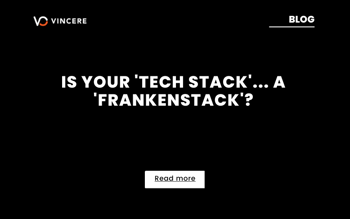Is your recruitment ‘tech-stack’, in reality, a ‘debt-stack’?
Or worse...a ‘Frankenstack’?
Over the years, recruiters typically bolt on a hotchpotch of systems or apps to their staffing CRM. Each to solve a different pain-point, with hopes for greater profitability and productivity.
It’s an easy trap to fall into.
I should know, I built a rectech Frankenstack of my own.
When I was running my agency, I had over 300 consultants across two countries and a tech stack that sucked time, money and choked growth. The CRM that I hosted on-premise in two offices, required full-time support engineers. Our back-office team spent 1 week per month processing paper timesheets. My ‘analytics’ was stuck firmly in Excel hell.
I believe the Recruitment Tech space is currently dominated by the Frankenstack.
What is a RecTech ‘Frankenstack’?
A Frankenstack is a collection of disparate software tools mish-mashed together. Different tech vendors to deal with. Multiple invoices at the end of each month. Integration failure points and, crucially, nothing working in two-way sync.
The recruitment Frankenstack exists in many forms, here are three of the most common:
1. The ‘Marketplace’ Frankenstack
This is the CRM vendor that outsources key features to the third parties in their marketplace.
Elements that are essential to growing your business - think online timesheets, Candidate/Client portals, TV dashboards, decent analytics - are provided by ‘partners’ instead of the CRM vendor.
These guys work on the theory that, once you are using a few of the third party apps in their marketplace you’ll be trapped into staying with them.
More vendors equals more problems. Misaligned contract end-dates and the classic ‘vendor blame game’ as soon as there’s an issue with integrations.
The ‘Marketplace’ Frankenstack has risen to dominance in the market over the past 10 years. Expect a lot of compromises and hidden costs.
2. The ‘Platform-Play’ Frankenstack
Typical examples are applications like Salesforce.com or Microsoft Dynamics. They rely heavily on partners to deliver services and the platform itself.
This Frankenstack requires you to spend big on ‘integration’ and ‘customization’. A lot of ‘yes’ in the sales process, followed up by a lot of teeth-sucking once you sign up (Can you tell, I am speaking from personal experience here?).
If you opt to ‘customize’, you’re in danger of writing yourself out of future release roadmap. Ultimately you end up with a bastardised platform that no-one likes using.
This Frankenstack is impossible to budget for, so get your cheque book ready.
3. The ‘Build-your-Own’ Frankenstack
A custom-built mess of hardware and software. Typically stitched together over years by a small team of developers to support changing business needs. You own all the problems.
A nightmare to move away from, this Frankenstack inhibits growth.
A ‘Frankenstack’ is a ‘Frankenstack’. The bolts don’t go away.
Over the past decade, the rush to the Cloud combined with a proliferation of rec-tech apps have contributed significantly to the rise of the Frankenstack. Anyone with a credit card can add new tools to their ‘tech stack’ within seconds, without thinking hard about the implications for the recruitment business.
But they have glossed over one crucial thing: all the heavy lifting required to truly make things work together. The type of deep integration that allows your systems to speak to each other. Properly.
Think about it: Are your tools fully connected in a two-way sync? Or are your teams still bogged down by admin?
Oracle’s co-president said it best in an article in AdAge, "The fact that everything ever works perfectly together, anybody who tells you that is pulling your leg…There will never be a day where the depth of integration, unless it was all built from the bottom ground up, will be integrated as any of us would like."
My teams work closely with recruiters all day, slaying Frankenstacks of all shapes and sizes. From the ‘horror stories’ we’ve gathered, the piecemeal practice of collecting different pieces of tools to create a ‘tech stack’ only has one real ending: death to growth.
The outlook right now: jobs are on the rise, our industry’s outlook is buoyant and powered by a renewed desire to succeed. Scr*w COVID. Loads of our customers have had a massive Q1.
If growth is your agenda for 2021 and beyond, a tech stack audit is one you definitely cannot afford to ignore.
Take a peek under the hood of your ‘tech stack’, do you see the bolts?
